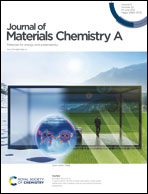Facile solvent-free synthesis of multifunctional and recyclable ionic conductive elastomers from small biomass molecules for green wearable electronics†
Abstract
The emergence of ionic conductive elastomers (ICEs) is significant for various electric applications. However, existing ICEs have mainly originated from tedious preparations, nonrenewable starting materials, and suffer from limited functions, especially non-recyclability. Here, a facile solvent-free synthesis was developed to directly convert small biomass molecules, α-lipoic acid (LA) and itaconic acid (TA), into processable ICEs by just integrating three dynamic chemical bonds into polymer networks. High-density molecular interactions endow the resultant ICE with a combination of properties including high transparency, good ionic conductivity, desirable mechanical performance, fast self-healing abilities, surface adhesion, and strain sensitivity. Impressively, the ICE can be fully recycled and reused by simple heating without the obvious sacrifice of the original functions. Before and after recycling, ICEs can be assembled as wearable strain sensors and flexible touch keyboards to precisely detect and distinguish the motions of joints in basketball training and English words, respectively. This work provides an efficient means for solving the long-standing contradiction between multiple performances and the simple fabrication of ionic conductive materials, proposing a promising candidate for the next-generation green wearable electronics.



 Please wait while we load your content...
Please wait while we load your content...